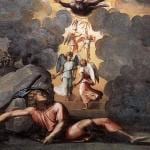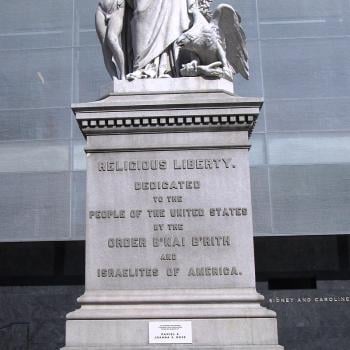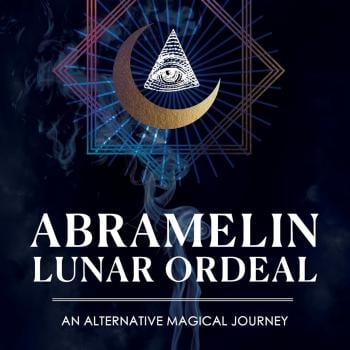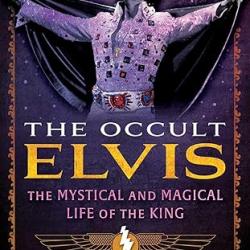Monday December 14
Monday December 14 is the day the Electoral College will officially confirm the President-elect. At this stage It appears almost certain that it will be Joe Biden and that Donald Trump’s presidency will officially end.
Monday December 14 is set to see a comet, a meteor shower and a total eclipse of the sun visible in some parts of the Earth. There is also a new moon on this day.
Over the first three weeks of December, Saturn and Jupiter are moving closer together and will reach their closest point on the solstice – December 21, 2020.
The Jewish festival of Hannukah, this year is celebrated from December 10 to 18.
Saturnalia, the ancient Roman festival and holiday in honor of the god Saturn, was held through December 17 to 23.
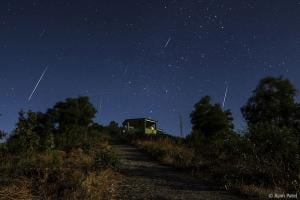
Geminids Meteor Shower in northern hemisphere, December 2013.
Geminid meteor shower
The Geminid meteor shower will peak at 2am December 14, 2020.
“The Geminid meteor shower – always a highlight of the meteor year – is expected to peak in 2020 on the night of December 13-14 (Sunday evening until dawn Monday). This year’s shower should be grand! The Geminids are typically a very reliable shower if you watch at the best time of night, centered on about 2 a.m. for all parts of the globe, and if you watch in a dark sky. And this year there’s no moon to ruin the shower. The meteors tend to be bold, white and quick. This shower favors Earth’s Northern Hemisphere, but it’s visible from the Southern Hemisphere, too. The curious rock comet called 3200 Phaethon is the parent body of this shower.
On a dark night, near the peak, you can often catch 50 or more meteors per hour. On an optimum night for the Geminids, it’s possible to see 150 meteors per hour … which might happen this year, given the moon-free skies accompanying this year’s Geminid meteor shower. New moon falls on December 14, 2020. On the mornings before that date, you’ll see a waning crescent moon.”
“The Greeks and Romans believed that the appearance of comets, meteors and meteor showers were portentous. They were signs that something good or bad had happened or was about to happen. …
The Roman historian Cassius Dio referred to ‘comet stars’ occurring in August 30BC. These are mentioned as among the portents witnessed after the death of the Egyptian queen Cleopatra. Experts are not entirely sure what it means when Dio uses the plural term ‘comet stars’, but some have connected this recorded event to the annual Perseid meteor shower.”
Total solar eclipse in parts of Chile and Argentina
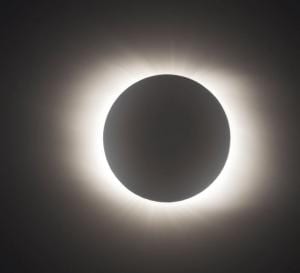
Total eclipse from Hangzhou, China 2009
“This total solar eclipse, the last eclipse of 2020, is visible from parts of Chile and Argentina in the afternoon. Some locations in southern South America, south-west Africa, and Antarctica will see the partial phase of this South American total solar eclipse, if the weather permits.”
In many ancient cultures, solar and lunar eclipses were regarded as heavenly signs. “Solar eclipses have historically been viewed as omens that bring about death and destruction.”
Astronomical observations by the Chinese, Egyptians, Babylonians and Greeks enabled them to “calculate the dates and paths of future and past eclipses with great accuracy. Some ancient eclipse records have been particularly significant to astronomers and historians as they enabled certain historical eras and events to be dated accurately.”
An eclipse would give the impression “that the natural order of the cosmos was disrupted.”
I think it’s fair to say that knowing when an eclipse was going to take place would remove most of the dread that earlier people had felt.
Perhaps a New Age understanding of eclipse would be most relevant?
“eclipses are a period of flux, due to both internal or external circumstances.
People often expect to be forced to confront change in a way that may be uncomfortable, but can ultimately lead to maturity.
Lunar eclipses and solar eclipses are both times when sudden changes occur in our lives, but many people do not understand the different ways these changes take form.”
An eclipse, thus is a time of rapid change that may be uncomfortable.
Comet C/2020 S3 (Erasmus)
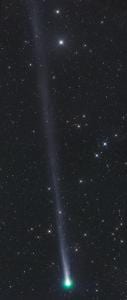
Comet 2020 S3 Erasmus
“Anyone lucky enough to be in South America for this eclipse might also be able to catch a glimpse of the third astronomical event set to light up the sky on Monday. Comet C/2020 S3 (Erasmus), is set to be just 11 degrees from the sun during the eclipse, although it’s not clear whether the comet will actually be bright enough to be visible to the naked eye. The comet in question was discovered in September by astronomer Nicolas Erasmus at the South African Astronomical Observatory, and only passes through the inner Solar System once every 2,000 years.”
On this day, the comet will be only 25 days away from its closest approach:
“Between January 2013 and December 2100, the closest approach of Comet C/2020 S3 (Erasmus) to Earth happens on Thu Nov 19 2020 at a distance of 1.037768 Astronomical Units, or 155,247,915 kilometers.”
“The Greeks and Romans believed that the appearance of comets, meteors and meteor showers were portentous. They were signs that something good or bad had happened or was about to happen. …
In the spring of 44BC, a comet that appeared was interpreted as a sign of the deification of Julius Caesar, following his murder. Caesar’s adopted son Octavian (soon to be the Emperor Augustus) made much of the comet, which burned in the sky during the funerary games held for Caesar. This portentous event was frequently celebrated in the ancient sources. In his epic poem, the Aeneid, Virgil describes how ‘a star appeared in the daytime, and Augustus persuaded people to believe it was Caesar’.
Augustus celebrated the comet and the deification of his father on coins (it did help to be the son of a god when trying to rule the Roman Empire), and many examples survive today.”
“A comet looks like a portent, and it is not surprising that people always regarded them as such. Writing 2000 years ago, the Roman astrologer Marcus Manilius summed up the prevailing opinion: ‘Heaven in pity is sending upon Earth tokens of impending doom’. Included in his list of cometary ills were blighted crops, plague, wars, insurrection, and even family feuds. In short, anything could be blamed on comets, and usually was. …
In the second century AD, the Greek astronomer Ptolemy reported in his Tetrabiblos that comets contained everything you needed to make a detailed prognostication, provided you knew how to read the signs aright: ‘They show, through the parts of the Zodiac in which their heads appear and through the directions in which their tails point, the regions upon which the misfortunes impend. Through the formations of their heads they indicate the kind of the event and the class upon which the misfortune will take effect; through the time which they last, the duration of the events; and through their position relative to the Sun likewise their beginning.’ Similar claims were still being made in the Middle Ages, and such beliefs have not entirely died out even today.”
“Comets have inspired dread, fear, and awe in many different cultures and societies around the world and throughout time. They have been branded with such titles as ‘the Harbinger of Doom’ and ‘the Menace of the Universe.’ They have been regarded both as omens of disaster and messengers of the gods. …
Comets’ influence on cultures is not limited simply to tales of myth and legend, though. Comets throughout history have been blamed for some of history’s darkest times. In Switzerland, Halley’s Comet was blamed for earthquakes, illnesses, red rain, and even the births of two-headed animals. The Romans recorded that a fiery comet marked the assassination of Julius Caesar, and another was blamed for the extreme bloodshed during the battle between Pompey and Caesar. In England, Halley’s Comet was blamed for bringing the Black Death. The Incas, in South America, even record a comet having foreshadowed Francisco Pizarro’s arrival just days before he brutally conquered them. Comets and disaster became so intertwined that Pope Calixtus III even excommunicated Halley’s Comet as an instrument of the devil, and a meteorite, from a comet, became enshrined as one of the most venerated objects in all of Islam.”
Given that Comet C/2020 S3 (Erasmus) will be barely visible, I hope that any destructive elements it brings will be minimal.
Dark moon and Hekate
Hekate “first appeared in Hesiod where she was portrayed as harmless, was not mentioned in Homer, and emerged in the fifth century as being associated with magick and witchcraft, lunar lore, creatures of the night, dog sacrifices, and illuminated cakes (sacrificial cakes with lit miniature torches), as well as doorways and crossroads. She was venerated in liminal places such as forks in the road. Her favorite offerings included red mullet (a scavenging fish tabooed in other cults), illuminated cakes (which could also be offered at the full moon), and puppies. Suppers of Hekate (offerings at the crossroads on the new moon) consisted of breadstuffs, eggs, cheese, and dog meat.
Hekate was equated with Artemis from the fifth century BCE onward. She was portrayed as a virgin carrying torches (although these were sometimes also carried by Artemis) and accompanied by dogs. She was known as the goddess of the crossroads, which were actually meeting places of three pathways. Her triple-form character arose from the practice of hanging three masks at crossroads. Like Artemis, Hekate was a goddess of the moon (aspected to the dark of the moon), and as such, was much invoked by Thessalian witches.
Hekate may have originally come from Caria [Karia] in Asia Minor. According to Hesiod her name means ‘she who has power far-off ’ and Zeus honored her more than any other deity, giving her power over land, sea and sky.”
“… the wealthy would leave offerings of dinner, consisting of bread and other things, to Hekate on the thirtieth, while the poor would live off these offerings. The thirtieth was the new moon and the offerings would traditionally be left at a crossroads. This is a form of social welfare … “
While Hekate does have a dark side, being much favored by witches, she was also associated with charitable offerings to the poor.
[Mierzwicki, Hellenismos, 48-9, 72]
‘Great conjunction’ of Jupiter and Saturn on the winter solstice
“Jupiter and Saturn will have their closest encounter in almost 400 years on the solstice (Dec. 21). …
A conjunction happens when planets appear incredibly close to one another in the sky because they line up with Earth in their respective orbits. Over the first three weeks of December, Saturn and Jupiter can be seen near the southwest horizon in the hour after sunset slowly getting closer with each passing night, according to a NASA skywatching statement about this month’s nocturnal highlights.
When these two planets converge on Dec. 21 they will be the closest they’ve been to one another in the night sky since 1623, according to Joe Rao, instructor at the Hayden Planetarium in New York. But that conjunction wasn’t visible to skywatchers on much of the Earth because of its location in the night sky. The last time the event was visible from most of the Earth was in 1226, according to Virginia Tech astronomer Nahum Arav.”
On December 14, Jupiter and Saturn will appear to be very close, and only seven days away from their great conjunction.
“Jupiter, the King of the Gods, is the ruler of Sagittarius. In Astrology, Jupiter is a planet of plenty. It is tolerant and expansive. The first of the social planets, Jupiter seeks insight through knowledge. Some of this planet’s keywords include morality, gratitude, hope, honor, and the law. Jupiter is a planet of broader purpose, reach, and possibility.
Jupiter has generally been associated with good luck and bounty. Optimism and growth (including mental and spiritual growth) come under its rule. On the up side, Jupiter is associated with a sense of humor, good will, and mercy. The more negative manifestations of Jupiter include blind optimism, excess, and overindulgence. Irresponsibility that results from blind optimism, not ill will, can be displayed.”
Given the circumstances attached to December 14, the important aspects to consider for Jupiter in my opinion are being “King” (president), “law” (constitution and whether any criminal activity has been engaged in), and the negative manifestations including “blind optimism, excess, and overindulgence.”
“In astrology, Saturn is associated with restriction and limitation. Where Jupiter expands, Saturn constricts. Although the themes of Saturn seem depressing, Saturn brings structure and meaning to our world. Saturn knows the limits of time and matter. Saturn reminds us of our boundaries, our responsibilities, and our commitments. It brings definition to our lives. Saturn makes us aware of the need for self-control and of boundaries and our limits.
Saturn is often associated with our fathers or father/authority figures. In childhood, the discipline, rules, and regulations imposed on us by our authority figures–from parents, teachers, and the like–were not always pleasant, but they actually helped us to understand the world around us. Similarly, Saturn’s lessons actually help us to grow.”
The important aspects to consider for Saturn are that it “is associated with restriction and limitation.”
As Saturn and Jupiter come into conjunction, I see presidential power being restricted and limited, along with legal transgressions. As the negative manifestations of “blind optimism, excess, and overindulgence” are restricted, the positive aspects of “bounty, optimism and growth” will be allowed to manifest again.
Hannukah
“The eight-day Jewish celebration known as Hanukkah or Chanukah commemorates the rededication during the second century B.C. of the Second Temple in Jerusalem, where according to legend Jews had risen up against their Greek-Syrian oppressors in the Maccabean Revolt. Hanukkah, which means “dedication” in Hebrew, begins on the 25th of Kislev on the Hebrew calendar and usually falls in November or December. Often called the Festival of Lights, the holiday is celebrated with the lighting of the menorah, traditional foods, games and gifts.”
“Because the Jewish calendar is lunisolar, the date of Hannukah changes each year. It always falls between late November and December, four days before the new moon.
This year, Hannukah begins today, Thursday December 10, and runs through to Friday December 18.
The Hebrew calendar date is 25 Kislev.”
This year, Hannukah is centered around December 14.
A wonderful interpretation of Hannukah comes from Rabbi Reeves:
“Most Jewish holidays are anchored to a full moon or a new moon (or are periodic, like Shabbat.) Chanukah always starts on a waning moon during the darkest time of year in the Northern Hemisphere, moving through the new moon closest to winter solstice and ending with waxing light. The lights of this holiday are so needed at this time of year on multiple levels, and ritualistically confronts the very heart of darkness.“
As it is said, out of the darkness is born the light!
Saturnalia
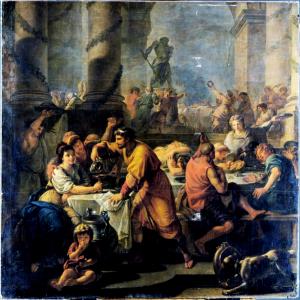
Saturnalia by Antoine Callet
Saturnalia, the most popular of Roman festivals. Dedicated to the Roman god Saturn, the festival’s influence continues to be felt upon the celebrations of Christmas and the New Year has been direct. Christmas was celebrated on the birthday of the unconquered sun (dies solis invicti nati).
“Originally celebrated on December 17, Saturnalia was extended first to three and eventually to seven days. The date has been connected with the winter sowing season, which in modern Italy varies from October to January. Remarkably like the Greek Kronia, it was the liveliest festival of the year. All work and business were suspended. Slaves were given temporary freedom to say and do what they liked, and certain moral restrictions were eased. The streets were infected with a Mardi Gras madness; a mock king was chosen (Saturnalicius princeps); the seasonal greeting io Saturnalia was heard everywhere. The closing days of the Saturnalia were known as Sigillaria, because of the custom of making, toward the end of the festival, presents of candles, wax models of fruit, and waxen statuettes which were fashioned by the sigillarii or manufacturers of small figures in wax and other media. The cult statue of Saturn himself, traditionally bound at the feet with woolen bands, was untied, presumably to come out and join the fun.”
Clearly, Saturnalia marked a period of much rejoicing, but it was also a time for venerating the god, Saturn. I see such veneration as increasing the influence of the Saturn energy in a ritualistic context.
Putting it all together
The comet and meteor shower are both portents of something about to happen, quite often bad – for the loser, events will be bad, but good for the winner.
The total eclipse indicates a time of rapid change – within the space of a day, one man will be announced president, while the other will have to resign himself to campaigning in four years.
The dark moon and Hekate indicates things improving for the poor.
The conjunction of Saturn and Jupiter appears to indicate presidential power being restricted and limited, along with legal transgressions, and a movement into a more positive manifestation of Jupiter energy.
I see the Hannukah energy confronting darkness to allow the rebirth of the light.
I see the Saturnalia energy as a period of much rejoicing and happiness, partly due to increasing the influence of the Saturn energy over Jupiter.
I can only foresee one outcome on the basis of the above, but will leave it for readers to draw their own conclusions.
The reference text for this article is:
Tony Mierzwicki, Hellenismos: Practicing Greek Polytheism Today
Tony Mierzwicki
Author of Hellenismos: Practicing Greek Polytheism Today and Graeco-Egyptian Magick: Everyday Empowerment.

